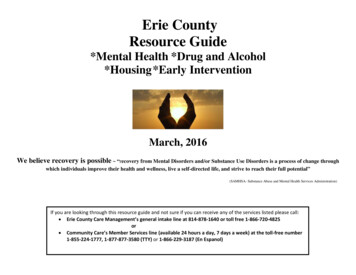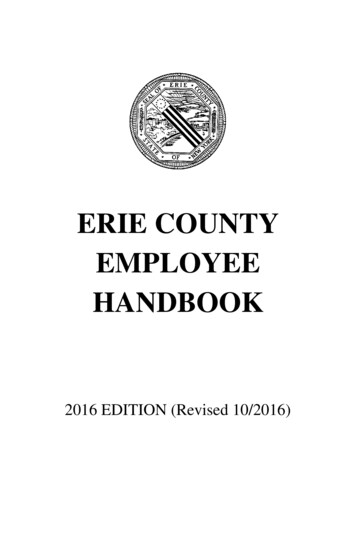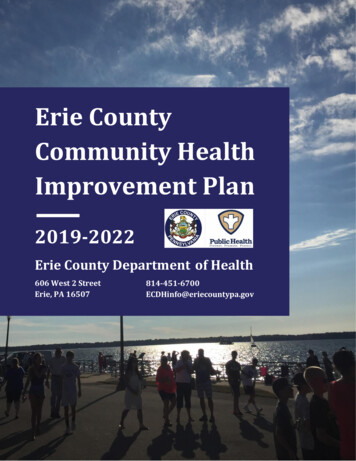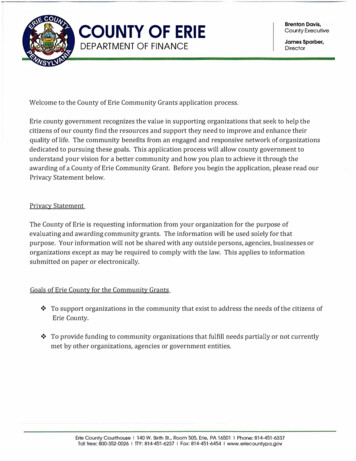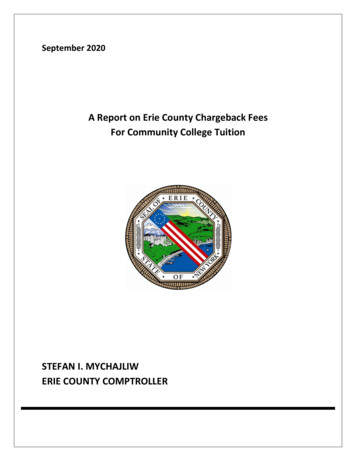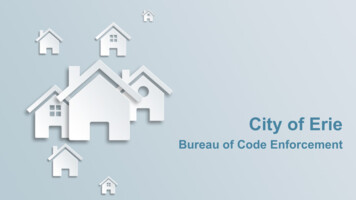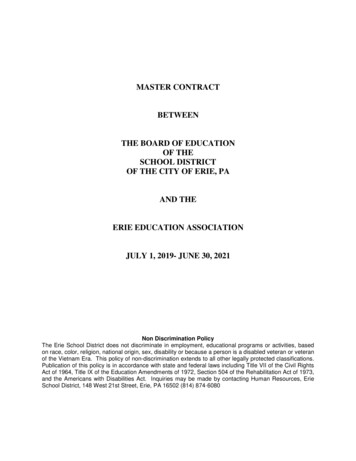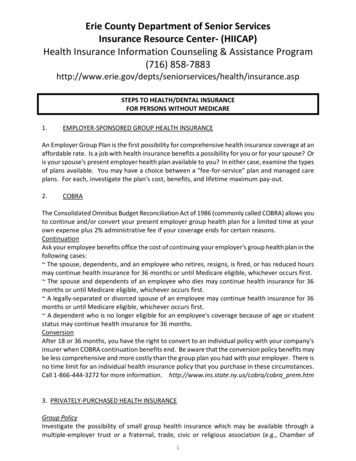
Transcription
COUNTY OF ERIEM ARK C. P OLONCARZCOUNTY EXECUTIVEG ALE R. B URSTEIN , MD, MPHCOMMISSIONER OF HEALTHThe mission of the Erie County Department of Health (ECDOH) is to promote and protect the health, safety, and well-being of ErieCounty residents through active prevention, education, enforcement, advocacy and partnerships.1
COUNTY OF ERIEM ARK C. P OLONCARZCOUNTY EXECUTIVEG ALE R. B URSTEIN , MD, MPHCOMMISSIONER OF HEALTHPART AA Message to the CommunityThe Erie County Department of Health worked with Kaleida and Catholic Health Systems, and a diverse group ofcommunity partners to create the Erie County Community Health Assessment & Community Health Improvement Plan2019-2021 (CHA/CHIP). The CHA/CHIP is a comprehensive review and analysis of health status indicators, public health,socioeconomic, demographic and other qualitative and quantitative data from the service area of Erie County, NY inalignment with the New York State Department of Health’s 2019-2024 Prevention Agenda.This report utilized primary (surveys, interviews and focus groups) and secondary (data from third party sources, i.e., USCensus Bureau) disease incidence and prevalence data for Erie County. The data was reviewed and analyzed and used tostrategically identify community health priorities, develop interventions, and commit resources to improve the healthstatus of the region.The CHA-CHIP can be used as a resource for health care providers, policy makers, social service agencies, communitygroups/ organizations, religious institutions, educational institutions, businesses, and consumers who are interested inworking toward improving the health status of Erie County and the overall quality of life of its residents. It is the intentof the ECDOH and the community partners that worked with them to create this report, that the information presentedis not only a useful community resource, but is a catalyst for new ideas, effective collaborations, interventions andcampaignsPartner OrganizationsErie County Department of HealthKaleida Health SystemsCatholic Health SystemsThe mission of the Erie County Department of Health (ECDOH) is to promote and protect the health, safety, and well-being of ErieCounty residents through active prevention, education, enforcement, advocacy and partnerships.2
COUNTY OF ERIEM ARK C. P OLONCARZCOUNTY EXECUTIVEG ALE R. B URSTEIN , MD, MPHCOMMISSIONER OF HEALTHACKNOWLEDGEMENTSThank you to all of our community partners that came together to assist with the planning and completionof the Erie County Department of Health’s Community Health Assessment and Community HealthImprovement Plan. The information in this document would not be possible without the support andcontributions of our valued community partners as well as the authors of previously produced documents.The CHA and CHIP Planning Group & primary @erie.govKelly FletcherECDOHKelly.Fletcher@erie.govCheryll MooreECDOHCheryll.Moore@erie.govJohn GaeddertECDOHjohn.gaeddert@erie.govRoger DuryeaCHSrduryea@chsbuffalo.orgYvonne AskewCHSyaskew@chsbuffalo.orgKelly AsherLaurene Tumiel-Berhaltertumiel@buffalo.eduUB Family MedicineJonathan LindnerBuffalo Statelindnejf@buffalostate.eduAlan DelmericoBuffalo Statedelmeram@buffalostate.eduRenee CadzowD'Youville CollegeMary K ComtoisUnited WayBartholomew RodriguesKathleen TompkinsMegan WilsonStephanie ValenzuelaLisa Neffcadzowr@dyc.edumary da uUB Family rt.orgAmerican Heart AssociationMichele MercerMillennium CCMichael NanfaraProgram Coordinator PHCmmercer@millenniumcc.orgmnanfara@phcwny.orgA special thanks to:The Public Health AlliancePopulation Health Collaborative (WNY region PHIP)The Erie County Medical Examiner’s OfficeErie County Department of Health EpidemiologyThe Opiate Task ForceThe mission of the Erie County Department of Health (ECDOH) is to promote and protect the health, safety, and well-being of ErieCounty residents through active prevention, education, enforcement, advocacy and partnerships.3
COUNTY OF ERIEM ARK C. P OLONCARZCOUNTY EXECUTIVEG ALE R. B URSTEIN , MD, MPHCOMMISSIONER OF HEALTHExecutive SummaryThe Prevention Agenda is a six-year effort to make New York the healthiest state. Developed in collaborationwith 140 organizations, the plan identifies New York’s most urgent health concerns, and suggests ways localhealth departments, hospitals, and partners from health, business, education, and community organizationscan work together to solve them. The New York State Department of Health’s 2019-2024 Prevention Agendaserves as the blueprint for state and local action to improve the health of New Yorkers in five priority areasand to reduce health disparities for racial, ethnic, disability, socioeconomic and other groups who experiencethem.This report is a compilation of the results of the Community Health Assessment (CHA) conducted bythe Erie County Department of Health, Kaleida Health and Catholic Health Systems and the Erie CountyDepartment of Health’s Community Health Improvement Plan (CHIP) resulting from the CHA. Contained inthis report is a detailed assessment of the health status of the residents of Erie County and a prioritization ofthe health concerns identified. This report also contains the Erie County Department of Health’s CHIP andimplementation strategy for the next three years.In the spring of 2018 the Erie County Department of Health brought together the local hospitalsystems, Kaleida Health and Catholic Health, as well as decision makers from government agencies,educational institutions, service providers, community based organizations agencies and the Public HealthCollaborative (PHC) to create the CHA and CHIP Planning Group (CCPG). The group was tasked with assessingand prioritizing community health needs and priorities and selecting at least, two, common priorities areasfrom the NYS Prevention Agenda The selections would guide the Erie County Department of Health throughthe Community Health Improvement Plan process as well as Kaleida and Catholic Health Systems through theirindividual Community Service Plans. (To view specific partner and their roles please see Appendix A, page 6)The mission of the Erie County Department of Health (ECDOH) is to promote and protect the health, safety, and well-being of ErieCounty residents through active prevention, education, enforcement, advocacy and partnerships.4
COUNTY OF ERIEM ARK C. P OLONCARZCOUNTY EXECUTIVEG ALE R. B URSTEIN , MD, MPHCOMMISSIONER OF HEALTHAlthough the hospitals systems and the Erie County Department of Health completed the CommunityHealth Assessment together; and together, agreed on and selected the priority and focus areas that theywould work collaboratively to address in their Community Service Plans and Community Health ImprovementPlan (respectively), the decision was made for each partner to submit their own report to New York StateDepartment of Health. The partners believed doing so would allow each organization to expand their focus,interventions and work plans beyond those the partners would select through the collaborative process.Social determinants of health were given special attention through the assessment process.The assessment was planned and conducted using the NYS Prevention Agenda and its five identifiedpriority areas as a guide: (1) prevent chronic diseases; (2) promote a healthy and safe environment; (3)promote healthy women, infants and children; (4) promote well-being and prevent mental health andsubstance use disorders; and (5) prevent communicable diseases. Aside from health data; demographics,geography and socio-economic indicators were used to do the assessment. Other areas included or addressedin this report are social determinants of health, evidence based interventions, prioritization of needs andresources and capacity.Again, the Community Health Assessment (CHA) was conducted to identify significant health needs asoutlined by New York State Department of Health’s 2019-2024 Prevention Agenda and, from that assessment,select at least two Prevention Agenda Priority areas to focus on collaboratively. The CHA & CHIP PlanningGroup (CCPG) developed a data collection plan which included a consumer survey, community and providerinput from several community and provider focus groups and data gathered from vital statistics, epidemiologydata bases, research studies, hospitals and other sources (a full list of sources can be found in the data analysissection of the CHA). The gathered data was then used to conduct a comprehensive and reliable assessment ofthe population’s health status and health challenges. Regional, state, county, sub-county data and dataThe mission of the Erie County Department of Health (ECDOH) is to promote and protect the health, safety, and well-being of ErieCounty residents through active prevention, education, enforcement, advocacy and partnerships.5
COUNTY OF ERIEM ARK C. P OLONCARZCOUNTY EXECUTIVEG ALE R. B URSTEIN , MD, MPHCOMMISSIONER OF HEALTHgathered in the Community Health Survey, and the Community Conversations developed by the group, wereanalyzed to review trends and compare Erie County’s health indicators to state goals and local averages.The group developed a rating/ criteria prioritization system (described more thoroughly in the dataanalysis section of this report) to identify the biggest health concerns/needs in Erie County; prioritize thoseconcerns/needs and decide which priorities our organizations had the capacity to address. Following are thetop three priorities areas, as aligned with the NYS Prevention Agenda, selected by Erie County Department ofHealth (ECDOH), Kaleida Health Systems and Catholic Health Systems to work on for the next three years: (1)prevent chronic diseases with a disparity concentration on poverty; (2) promote Healthy Women, Infants andChildren; and (3) promote well-being and prevent mental health and substance use disorders with a disparity.ECDOH has selected the following priorities, focus areas and goals:Priority Area 1 - Prevent Chronic Disease (addressing the disparity of poverty); focus area 1: HealthyEatinand Food Security; Goal: 1.1: increase access to healthy and affordable fruits and vegetables; focus Area2: Physical Activity; Goal: 2.2: promote school, child care, and worksite environments that supportphysicalactivity for people of all ages and abilities; focus area 3: Tobacco Prevention; Goal: 3.1: preventinitiation of tobacco use, including combustible tobacco and electronic vaping products by youth and youngadults; Goal 3.2: promote tobacco use cessation, especially among populations disproportionately affected bytobacco use including: low SES, frequent mental distress/substance use disorder; LGBT; and disability; focusarea 4: Preventive Care and Management; Goal 4.2: increase early detection of CVD, diabetes, prediabetesand obesity; Goal 4.4: improve self-management skills for individuals with chronic conditions;Priority Area 2 – Promote Healthy Women, Infants and Children; Focus area 2: Perinatal & Infant Health;Goal: 2.1: Reduce infant mortality and morbidity 2.2 Increase Breastfeeding; Focus Area 4: Cross CuttingPrinciples applied for Healthy Woman, Infants, & Children.The mission of the Erie County Department of Health (ECDOH) is to promote and protect the health, safety, and well-being of ErieCounty residents through active prevention, education, enforcement, advocacy and partnerships.6
COUNTY OF ERIEM ARK C. P OLONCARZCOUNTY EXECUTIVEG ALE R. B URSTEIN , MD, MPHCOMMISSIONER OF HEALTHPriority Area 3 – Promote Well-being and Prevent Mental and Substance Use Disorders: Focus Area 2:Prevent Mental and Substance Use Disorders; Goal 2.2: Prevent opioid and other substance misuse and deathsThe evidence based and evidence informed interventions to address the focus areas and goals wereselected based on how well they addressed the established goals, if the intervention was already being usedby the partner’s agencies; the partner’s capacity to implement the intervention, and the cost of the intervention. TheCATCH program will be used to address Priority Area 1 Goal 2.2CATCH is an acronym for Coordinated Approach to Child Health. It is an evidence-based coordinated school healthprogram designed to improve nutrition and physical activity in students attending kindergarten through 8th grade.Another CATCH program, The CATCH My Breath will be used, along with the American Heart Association’s Quit Lyingprogram to address priority area 3, goal 3.1. Other evidenced based programs utilized in ECDOH’s CHIP are Stanford’sChronic Disease Self-Management Program (CDSMP) and Diabetes Self-Management Program (DSMP) and the NationalDiabetes Prevention Program (DPP) to address priority area 1 goal 4.2 and goal 4.4.The mission of the Erie County Department of Health (ECDOH) is to promote and protect the health, safety, and well-being of ErieCounty residents through active prevention, education, enforcement, advocacy and partnerships.7
COUNTY OF ERIEM ARK C. P OLONCARZCOUNTY EXECUTIVEG ALE R. B URSTEIN , MD, MPHCOMMISSIONER OF HEALTHHospital and Community PartnersAlthough the hospitals and the Erie County Department of Health will each be submitting their ownCommunity Health Improvement Plan, they worked together to develop their plans, partnered on someinitiatives and made certain that their priorities and interventions aligned and complemented each other. Thecollaborative approach taken will leverage the efforts and resources of all health organizations in thecommunity, resulting in increased effectiveness and sustainability of initiatives and interventions, reducedservice duplication and clear identification of system gaps.Tracking Evaluation and SustainabilityTo evaluate the impact, the 2019-2021 CHA-CHIP progress and improvement will be tracked through annualevaluation of the following data sources: NYSDOH Prevention Agenda dashboard data, County HealthRankings, EC Medical Examiner reports, hospital utilization data, along with other local data sources.The partners will continue to communicate and meet at least once per year during the implementation periodof the 2019-2021 CHIP. At each meeting, progress metrics will be reviewed to providing opportunity forvaluable conversation around quality improvement, including identification of barriers and sharing bestpractices. ECDOH will compile a brief progress report, share it with partners and post it on the ECDOHwebsites where the CHA and CHIP documents are posted in order to be transparent and accessible to thecommunity.The mission of the Erie County Department of Health (ECDOH) is to promote and protect the health, safety, and well-being of ErieCounty residents through active prevention, education, enforcement, advocacy and partnerships.8
COUNTY OF ERIEM ARK C. P OLONCARZCOUNTY EXECUTIVEG ALE R. B URSTEIN , MD, MPHCOMMISSIONER OF HEALTHB. Community Health AssessmentGeographyErie County is the largest metropolitan county inupstate New York with a population of 922,5781and covering 1,044 square miles. Erie County islocated in western New York, bordered to thewest by Lake Erie and the Niagara River, andshares an international border with Canada.Several bridges span the Niagara River andprovide convenient access and trade forresidents of the United States and Canada.Niagara County lies to the north, Genesee andWyoming Counties to the east, and Cattaraugusand Chautauqua Counties are to the south.There are three cities in the County. Buffalo is thesecond largest city in the state and the largestcity in the region with a population of 256,304.1Buffalo serves as the County seat. In addition,there are 16 villages, 25 towns, and two NativeAmerican Indian reservations within the County.Erie County is largely an urban County with themajority of the population living within the citiesand surrounding communities.That being said, there is also a significant ruralpopulation that resides outside the first andsecond ring suburban areas whose needs areaddressed differently due to sheer geographicdistances.Resident DemographicsThe population of the County appeared to be decreasing for the first half of the decade but, as the end of the decadenears, the population in Erie County appears to be growing slightly. According to the US Census, in 2010 the populationof Erie County was 919,040; in 2018 the population was estimated at 922,578; about a 1% increase in population.76% of the Erie County population is non-Hispanic Whites, 14% non-Hispanic African Americans, 5.2% Hispanic, 0.7%American Indian/Alaska Native, and 3.4% Asian.The City of Buffalo population is 47.4 % White; 36.7 % Black or African American; 11% Hispanic; 0.5 % NativeAmerican/Alaska Native; 5.6 % Asian; 0% is Native Hawaiian and/or Pacific Islander, and 5.8% is some other race. Anestimated 4.0% is one or more races.The mission of the Erie County Department of Health (ECDOH) is to promote and protect the health, safety, and well-being of ErieCounty residents through active prevention, education, enforcement, advocacy and partnerships.9
COUNTY OF ERIEM ARK C. P OLONCARZCOUNTY EXECUTIVEG ALE R. B URSTEIN , MD, MPHCOMMISSIONER OF HEALTHUpon deeper examination of the demographics of the County, there are significant differences in the racial compositionof the City of Buffalo as compared to the rest of Erie County. The City of Buffalo is characterized by a much higherpercentage of African Americans (36.7) and Hispanics (11.3%) than the county as a whole.According to the 2014 -2018 US Census BureauAmerican Community Survey an estimated92.9 percent of the people living in Erie County, NewYork are U.S. natives. 80.6 percent of the ErieCounty, New York population is living in the statewhere they were born. Approximately 7.1 percentof Erie County, New York residents in 2014-2018 areforeign-born. 51.7 percent of foreign born arenaturalized U.S. citizens and anestimated 68.3 percent entered the country beforethe year 2010.Foreign-born residents of Erie County, NewYork come from different parts of the world. The bargraph on the right displays the percentage of foreignborn from each world region of birth in 20142018 for Erie County, New York.The west side of Buffalo is home to a large immigrantand refugee population where there are 33ethnicities and more than 70 languages and dialectsspoken. Just south of Buffalo Lackawanna, New York,is home to a large Arab American community, many ofwhom do not speak English.According to the 2018 American Community Survey,among people at least five years old living in Erie County,New York in 2014-2018, 10.5 percent spoke a languageother than English at home. Spanish was spokenby 3.4 percent of people at least five yearsold; 3.8 percent reported that they did not speak English"very well."Languages Spoken at Home Other Than EnglishPercentSpanish3.4Other Indo-European languages3.5Asian and Pacific Islander languages1.9The disparities in health outcomes associated withurban, low income, racial minorities in the literature areprevalent and apparent when looking at data for theOther languages1.6inner city residents. Although there is a relatively smallpercentage of a minority population other than black,they are composed of the newly settling refugeeTable source: 20-14- 2018US Census Bureau American Community Surveypopulations that are bringing their existing health issuescommon to refugees with them such as TB and Giardia,unfortunately the refugees are quickly converting to theunhealthy American behaviors which contribute to high rates of chronic disease as they become assimilated to the wayof life in the United States.The mission of the Erie County Department of Health (ECDOH) is to promote and protect the health, safety, and well-being of ErieCounty residents through active prevention, education, enforcement, advocacy and partnerships.10
COUNTY OF ERIEM ARK C. P OLONCARZCOUNTY EXECUTIVEG ALE R. B URSTEIN , MD, MPHCOMMISSIONER OF HEALTHIncomeThe median household income in ErieCounty is 55,673 which is less than thatof New York State but significantly higherthan that of the City of Buffalo, which is 35,893. Disparities associated with lowsocioeconomic status are apparent evenwithout the comorbidities of minorityethnicity, lack of education andinadequate housing.Median Household Income 70,000.00 55673 60,000.00 65323 50,000.00 35,893 40,000.00 30,000.00 20,000.00 10,000.00To further compound this problem there 0.00is the discrepancy between male andMedianBuffaloErie County New York StateHouseholdfemale earnings for the same work. TheIncome 2014Source: US Censuscity of Buffalo has a large contingency of2018single parent families with single womenholding the title of head of household. Among those employed full time, the median earnings for males is 50,062.Disparately, the median earnings for a female full-time worker are 37,639, 25% less than that of their malecounterpart. The sustained economic depression created by this income disparity further exacerbates existing healthconcerns leading to further disparities in health status.Pay Equity between genders is an ongoing concern. Erie County continues fighting this disparity through efforts of theErie County Commission for the Status of Women. The Commission was established by a unanimous vote of the ErieCounty Legislature in 1987 to remove gender based inequities for women. In 1988, the Commission became adepartment of Erie County government. As noted on the Commission’s website: Women comprise 52% of Erie County's total population, 49.7 percent of its labor force, 59% of senior citizens,and 53% percent of the county’s registered voters.Women age 18-24 years: over 4000 have not graduated from high school, over 10,000 have a high school orequivalency diploma, over 22,000 have some college or associates degree and over 8600 have a Bachelor'sdegree or higher.The median annual earnings for women working full-time are 41,317, for men, 53,266.Median weekly earnings for women working full-time is 794 vs. 1024 for menOne in six girls and women live at below the poverty level in Erie County.1.2% of pregnancies are to teenage mothers, age 15-19, in Western New York.In Erie County in 2018 more than 10,000 incidents of domestic violence were reported to law enforcement.Of the almost 60,000 veterans in Erie County, approximately 3800 are women.Of the returning women veterans, 40% have mental health issues including depression, Post-Traumatic StressDisorder and Military Sexual Trauma.30% of families in Buffalo live in poverty with over 63% of families having women as head of household.Approx. 1,000 children are born each year to mothers without a high school diploma.25% of women in Erie County do not receive prenatal care.The mission of the Erie County Department of Health (ECDOH) is to promote and protect the health, safety, and well-being of ErieCounty residents through active prevention, education, enforcement, advocacy and partnerships.11
COUNTY OF ERIEM ARK C. P OLONCARZCOUNTY EXECUTIVEG ALE R. B URSTEIN , MD, MPHCOMMISSIONER OF HEALTHPovertyWhen looking at all families in Erie County,14.9% are living below the poverty levelwhich is similar to the NYS percentage of15.1%. In the city of Buffalo this numberjumps to 30.9% of the population. Forfamilies in Erie County as a whole, withchildren under 18 years of age, 18.4% livebelow the poverty level. The likelihood offamilies living below the poverty level iscompounded for single, female headedfamilies. 31.4% of families in Erie Countyhave a single, female head of householdand 12,898 of these families live below thepoverty level.Erie County’s per capita income in 2018dollars (2014-2018) was 32347. In theCity of Buffalo, poverty is significantlymore prominent. In Buffalo the per capitaincome is 23,397 almost 9,000 less thanthe County. The gap has widened byalmost 200 between the County of Erieand the City of Buffalo since the 2016 -18CHIP iChildren particularly are affected asshown in the accompanying map.The detailed view of the City of Buffalovisually emphasizes the serious financialdisparities of families with children ascompared to Erie County. The residentsmost in need of assistance reside in arelatively compact geographic segment ofthe county.DisabilityIn Erie County, New York, among the civilian noninstitutionalized population in 2014-2018, 13.2 percent reported adisability. The likelihood of having a disability varied by age - from 4.8 percent of people under 18 years old,to 10.7 percent of people 18 to 64 years old, and to 32.9 percent of those 65 and over.The mission of the Erie County Department of Health (ECDOH) is to promote and protect the health, safety, and well-being of ErieCounty residents through active prevention, education, enforcement, advocacy and partnerships.12
COUNTY OF ERIEM ARK C. P OLONCARZCOUNTY EXECUTIVEG ALE R. B URSTEIN , MD, MPHCOMMISSIONER OF HEALTHHouseholds and FamiliesErie County: In 2014-2018, there were 387,847 households in Erie County. The average household size was 2.30 people. Families made up 59.0 percent of the households in Erie County, New York.o married-couple families (41.6 percent) ando other families (17.4 percent).o Female householder families with no husband present and own children under 18 years are 7.2 percentof all households. Nonfamily households made up 41.0 percent of all households in Erie County; 26.5 percent of all householdshave one or more people under the age of 18; 29.8 percent of all households have one or more people 65 years and over. In Erie County, New York, 12,825 grandparents lived with their grandchildren under 18 years old. Of thosegrandparents, 41.4 percent were responsible for the basic needs of their grandchildren.City of Buffalo: In 2014-2018, there were 110,701 households in Buffalo city, New York. The average household size was 2.24 people. Families made up 50.8 percent of the households in Buffalo city, New York.o married-couple families (24.5 percent)o Other families (26.3 percent).o Female householder families with no husband present and own children under 18 yearsare 12.6 percent of all households. Nonfamily households made up 49.2 percent of all households in Buffalo city, New York. 27.7 percent of all households have one or more people under the age of 18; 22.8 percent of all households have one or more people 65 years and over. In Buffalo, New York, 4,829 grandparents lived with their grandchildren under 18 years old. Of thosegrandparents, 43.7 percent were responsible for the basic needs of their grandchildren.EducationAccording to NYSED in 2014-2015, the graduation rate for the Buffalo Public Schools was 57%. This statistic both reflectsand predicts poor social and emotional health and well-being in this population and once again reflects the effects ofsocioeconomic and racial disparities. In response to the low high school graduation rates in the city of Buffalo, the highunemployment rates, and involvement in criminal activities by the school aged youth the Buffalo Public School System,the City of Buffalo, the County of Erie, assorted philanthropic foundations and many community based organizationspartnered to form the Say Yes to Buffalo Collaborative.City of Buffalo & NYS 2019 Graduation RateSource: NYS Department of EducationThe mission of the Erie County Department of Health (ECDOH) is to promote and protect the health, safety, and well-being of ErieCounty residents through active prevention, education, enforcement, advocacy and partnerships.13
COUNTY OF ERIEM ARK C. P OLONCARZCOUNTY EXECUTIVEG ALE R. B URSTEIN , MD, MPHCOMMISSIONER OF HEALTHCity of Buffalo & NYS 2019 Graduation Rate by Race/EthnicitySource: NYS Department of EducationThe holistic, year-round support Say Yes Buffalo and its partners provide to Buffalo Public School District studentsthroughout their K-12 years and beyond is working. Acting on their belief that every student can graduate highschool and college when given the proper supports, resources, and opportunities is already paying dividends.According to the New York State Education Department (NYSED) the 2018-19 graduation rate for BPS was 65% anincrease of 8%.“Say Yes Buffalo” will continue to provide comprehensive supports, including locally funded tuitionscholarships of nearly 100 colleges and universities for those who meet residency, graduation and admissionrequirements. These supports are aligned with what research indicates is needed to enable every child in theprogram to achieve his or her potential.ii The chart below shows the disparity in graduation rates betweendifferent racial/ethnic groups. American Indian/Alaskan Native students have the highest graduation rate at 82%and the Hispanic/Latino students have the lowest at 57%.The total school enrollment in Erie County, New York was 218,807 in 2014-2018. Nursery school enrollmentwas 11,996 and kindergarten through 12th grade enrollment was 138,001. College or graduate school enrollmentwas 68,810.County of Erie & NYS 2018-19 Graduation Rate by Race/EthnicitySource: NYS Department of EducationThe mission of the Erie County Department of Health (ECDOH) is to promote and protect the health, safety, and well-being of ErieCounty residents through active prevention, education, enforcement, advocacy and partnerships.14
COUNTY OF ERIEM ARK C. P OLONCARZCOUNTY EXECUTIVEG ALE R. B URSTEIN , MD, MPHCOMMISSIONER OF HEALTHCounty of Erie & NYS 2018-19 Graduation RateSource: NYS Department of EducationFor individuals over the age ofEducational Achievement in NYS, Erie County, & Buffalo among residents25, Table 4 compares the highest 25yrseducational level achieved inDemographicsand Educational Level ofNYSErie CountyBuffaloNYS, Erie County and the City ofResidentsBuffalo. Erie County had anincrease of 1% in number ofHigh School Graduates8
The Erie County Department of Health worked with Kaleida and Catholic Health Systems, and a diverse group of community partners to create the Erie County Community Health Assessment & Community Health Improvement Plan 2019-2021 (CHA/CHIP). The CHA/CHIP is a comprehensive review and analysis of health status indicators, public health,
